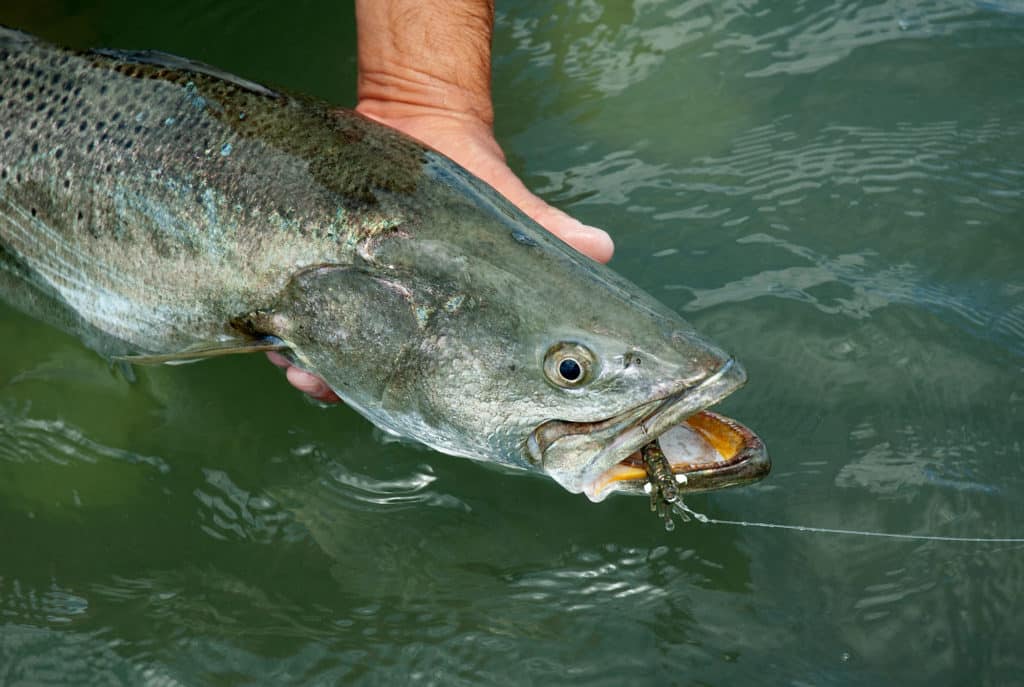
What would alligator gar, apex predators of the Louisiana coastal marsh that can exceed 300 pounds, have to do with speckled trout?
Not a thing, I had always assumed. That’s why a report of speckled trout wintering with alligator gar in the canals that flow into Sabine Lake on the Texas-Louisiana border seemed strange. In fact, it sounded downright crazy—until I saw it myself.
The fact is, speckled trout inhabit diverse habitats and feed on myriad organisms that many anglers ignore in pursuit of these popular sport fish. By taking an open-minded approach to catching trout, anglers can find success when others are scratching their heads.

Alligator Gar and Speckled Trout
While slowly working a remote canal that locals call the dredge hole, I noticed a number of big garfish. They were simply lying on the bottom in the shallow, tea-colored water, but when I made it to a deep S-turn. I saw something else.
I spotted a big trout positioned behind the gills of a 4-foot-long gar and saw two smaller trout with a gar of similar size on the opposite side of the turn. I flipped a luminescent-colored Corky in front of the trout, half expecting to spook the gar, but it didn’t move. Instead I caught the 25-inch trout.
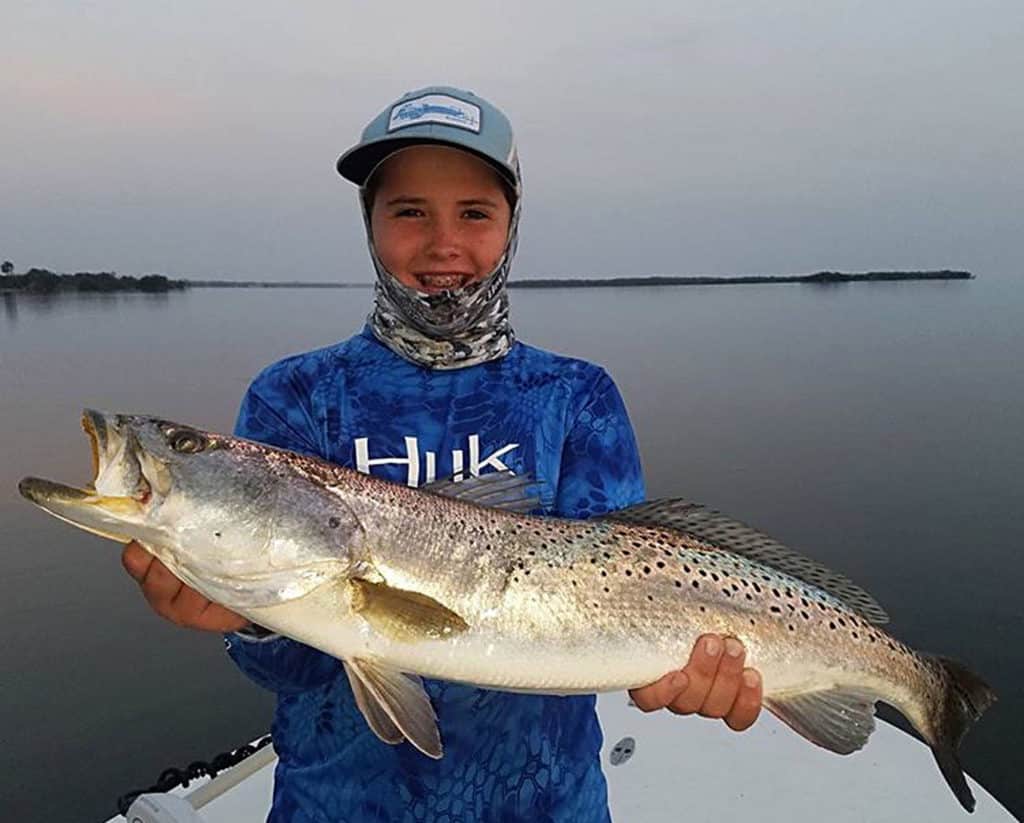
A handful of other anglers have reported encountering this phenomenon over the years, but for the most part, it has remained a secret.
Alligator garfish, according to Texas Parks & Wildlife Department officials, are proven trout predators, so exact reasons for this associative phenomenon remain mysterious. Gar feed very little in winter, and these canals—a little deeper than most in the marsh—provide more-stable water temperatures desired by both species. Perhaps both simply seek a place of refuge.
Had I not been tipped off to the gar/trout connection, I never would have noticed the trout. These days, all my winter expeditions into the deep marsh include slowing to examine, through polarized lenses, any gars that I see to look for trout sidekicks.
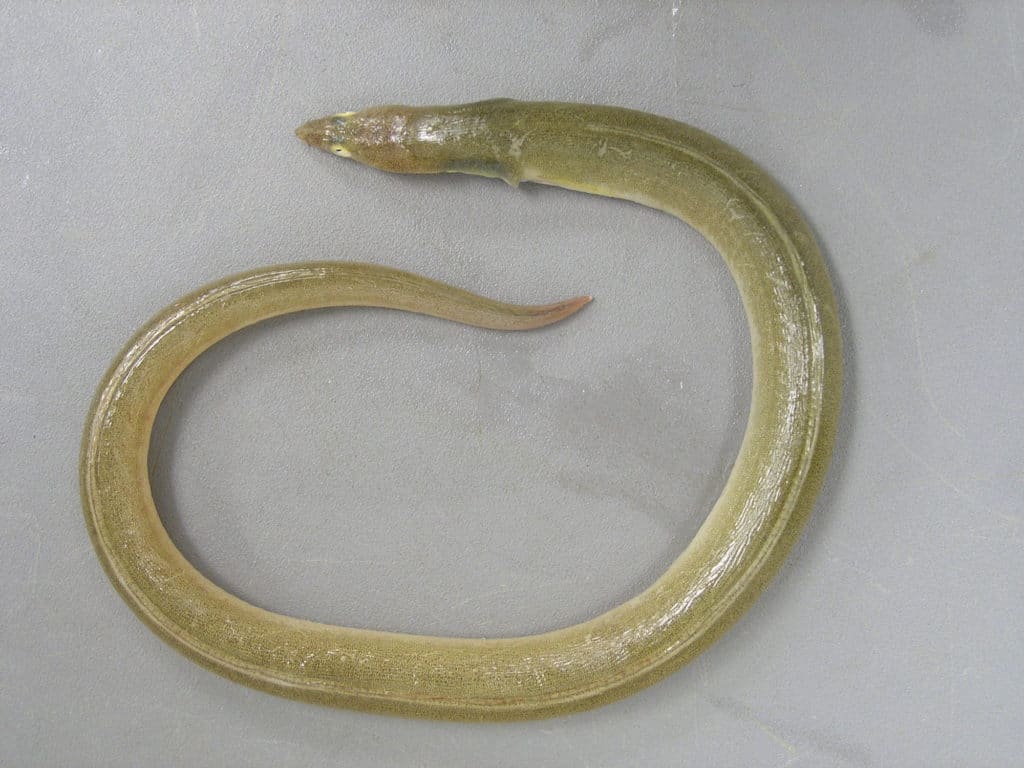
Eel Specks
During times of heavy rain and runoff, trout fishing can get downright tough because their tolerance for fresh water is not as liberal as that of reds or flounder. This is especially true for big trout.
At such times, savvy anglers fishing many Texas and Louisiana bays target reefs in depths to 15 feet—as in Sabine, in water much deeper than the surrounding bay, which typically averages 5 feet or so in the southern part of most bay systems. These reefs often link with the Intracoastal Waterway or a local ship channel that connects to the Gulf. Salt water is heavier than fresh, so these deeper areas have the salinity levels trout seek, and can be full of prey, including what anglers call sand eels.
In reality, they’re referring to the shrimp eel (a type of snakelike eel), common dwellers of sand- and mud-bottomed shores, reefs, and rock outcroppings.
Drifting an eel imitation on a 3/16 or ¼-ounce jig head along the bottom is a great way to find these reef-dwelling trout. The Norton sand eel is a popular choice, though I grew up fishing a Culprit worm. The latter is a bass bait but works like a charm for eel-eating trout.
Capt. Buzz Stansel designed the Hackberry Hustler to mimic an eel, but with the additional action of a paddle tail, it has become popular for drifting deeper waters for trout as well. I was introduced to the lure a few years back by the inventor’s son Capt. Guy Stansel, who, like his father, guides out of Hackberry Rod and Gun on Lake Calcasieu on the western Louisiana coast. “I typically fish them on a ¼-ounce leadhead when the trout are running on the reefs,” the younger Stansel says.
This practice requires patience and a large supply of plastics thanks to oyster snags. Some anglers let the lure drag with no action whatsoever, while others give it slight hops. Either method can produce, depending on the trout’s disposition that day.
In Sabine Lake, at least, any moving tide can produce, but look for incoming currents to give up the best action because they bring in fish from the nearby ship channel, along with a fresh influx of more saline water. A drift sock is crucial for this type of fishing because moving too fast renders the technique ineffective.
Read Next: 30 Trophy Seatrout Secrets from Top Captains
If you’re skilled with electronics, mark a spot as soon as you get bit or just throw over a marker buoy. Trout often school in incredibly small areas, so among acres without a bite, you can find tiny pockets of action. The key is being able to go back to the exact spot where you hooked up.
A 1 to 2-foot change in depth can make the difference whether you find trout or not in these shallow systems. Something else to consider is to look for structure on the structure. In other words, look for sudden drop-offs in the reef or places where large areas of an oyster bed quickly rise to the surface. There are always a couple of small natural channels on the southern end of the reefs leading toward the Gulf, so work those over heavily. Anything that stands out to you will stand out to a fish, so target anything that catches your eye or you notice on your sounder.

Pre-Dawn Predators
“You don’t want to hear a blowup; you want to hear a slurp.”
I will never forget when Joe Persohn, a Texas trout expert from Beaumont and known affectionately by his friends as the Jetty Man, gave me that tip about catching trout before dawn at the southern tip of the Sabine and Galveston jetties.
Persohn, who mastered the art of catching big trout at the jetties, was right on target with listening for the slurps. A blowup often means Spanish mackerel or a small blacktip shark, but every time I’ve heard that slight slurp sound followed by my plug disappearing, I would have a big trout on the other end.
In the early stages of my writing career, I fished the jetties from a 16-foot flat-bottomed aluminum boat. At first, I considered that boat a disadvantage but quickly learned otherwise. With the rugged aluminum boat, my cohorts and I were able to fish right against the rocks, where we noticed things that anyone with a more delicate fiberglass rig (and some common sense) never would have seen from a safe distance away.
First, we realized most of our bites came from small washouts from the Gulf side of the jetty to the channel. The trout were waiting as baitfish washed in and out of these spots. Second, many small Spanish mackerel, mullet and pogies held here, and that was what the trout fed on.
We always arrived about an hour before daylight and threw over a small floating light just so we could see what we were doing. Before the sun started peeking out, any topwater would get the job done. We would line up against the rocks and work across the washouts and down the length of the jetty wall. But once the sun emerged, the best action came on ½-ounce silver spoons that we would let flutter down and then rip back up. Most of the strikes were on the fall, but we would sometimes get bit while reeling up. A wire leader proved necessary at times, when mackerel outnumbered trout.
To this day, I never jetty-fish without silver spoons and, if possible, I get there before dawn to get in on the early action. I’ve caught nice trout at jetties later in the day, but the fishing is never as good as from about an hour before sunrise until about 30 minutes after.
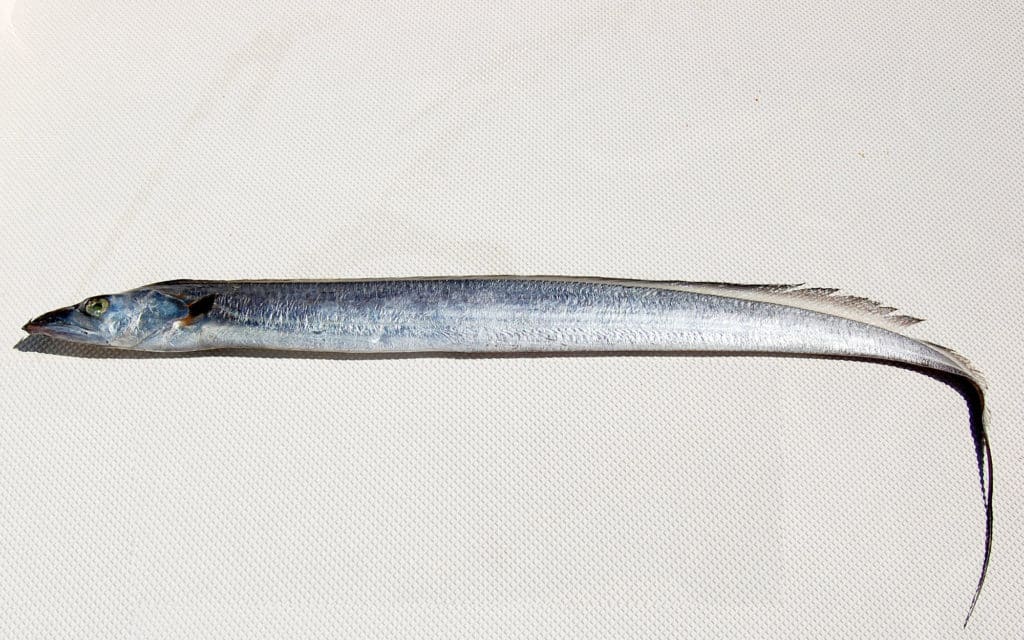
Hunting Ribbonfish
Atlantic cutlassfish, known more commonly as ribbonfish, are considered a nuisance by most anglers. Other than the fact that ribbonfish are an excellent bait for offshore pelagics, anglers find no redeeming value in these toothy creatures that steal bait with incredible precision.
These anglers are looking at ribbonfish all wrong.
During times of heavy salinity, large numbers of them enter bay systems, where they often become the preferred prey of big speckled trout. The key is being able to distinguish when ribbonfish are breaching the surface while feeding, and when they breach because trout are feeding on them.
That’s really pretty simple. Ribbonfish typically feed on pogies, and when you see the little menhaden jumping and slicks forming, you know ribbonfish are preying on them. If you see ribbonfish (usually smaller ones) jumping with no other visible baitfish activity, there’s a good chance speckled trout are beneath the fracas.
Ribbonfish move fast, and to keep up, trout have to as well, so have your trolling motor down and pedal to the floor. A silver casting spoon (such as a half-ounce Johnson Sprite) is a necessity because you can throw it a long distance, and the flash mimics the shine of a ribbonfish. Throw the lure past the action and reel through it as fast as you can because the ribbonfish move quickly, and something plodding along is not likely to get struck.
If you are fortunate enough to have the school move toward you or can stay with them without spooking the specks, then a jerkbait is hard to beat. A favorite of mine, Daiwa’s sinking Salt Pro Minnow Bullet, can be worked from the surface to the bottom. Give it a shot on the surface first, but be forewarned that some of the ribbonfish might forget they’re being chased and attack. The best action is typically a couple of feet beneath the surface (and the ribbonfish) and in the zone of the big trout. Just work the jerkbait quickly, and watch it do wonders.
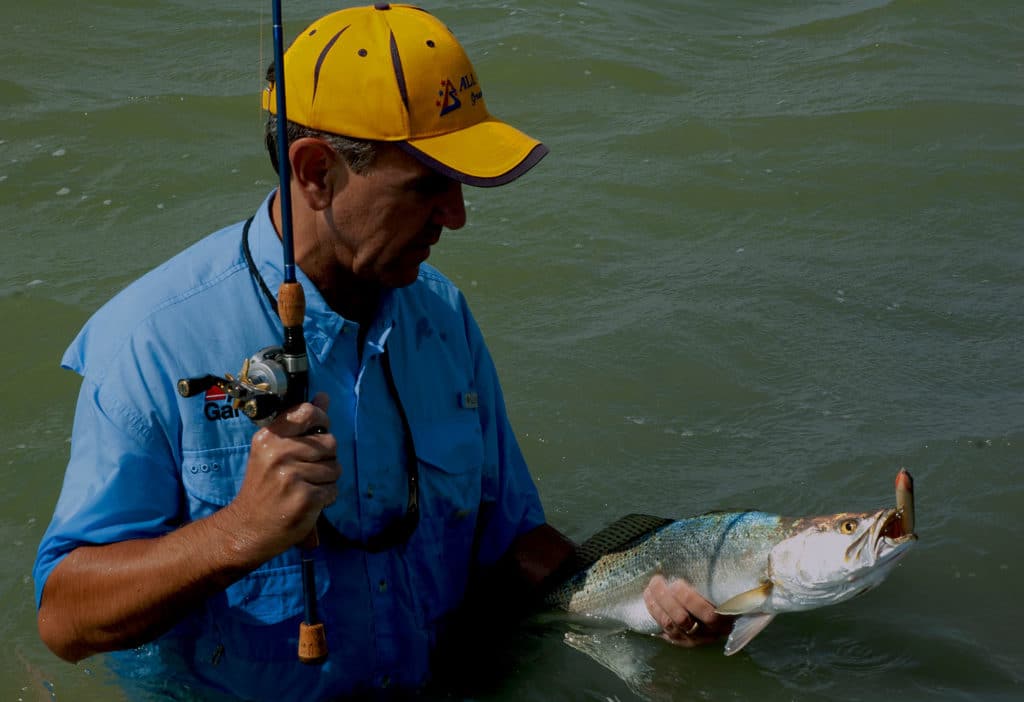
Winter Worms
On a morning in February 1996, my father, Chester Moore Sr., and I fished Keith Lake Cut south of Port Arthur, Texas. When we hit the water that morning, millions of tiny ½- to 1-inch worms swarmed on the surface—and the trout were in an absolute feeding frenzy.
I later learned these were a species of marine worm that occasionally undergoes mass hatches. I realized an overlooked strategy for winter trout fishing: utilizing worm imitations. Baitfish can be scarce during winter months, but according to officials with the University of Southern Mississippi Gulf Coast Research Laboratory, trout will turn to worms, particularly during winter.
I have caught trout while flounder fishing with drop-shot rigs during winter using curl-tailed grubs that mimic worms. A drop-shot, which rigs hook and lure above a weight, is a phenomenal rig for vertical fishing but can also be used for working any kind of structure at any depth. Try a 2- to 3-inch worm imitation or a Gulp! Saltwater Worm fished from a spinning rig. Work deep spots in ship channels and around reefs on the southern tier of bays, and also some of the deeper bayous feeding into the open water.
Trout can be super finicky in winter, so trying some unusual methods like these might offer success when other methods fail. Heavily pursued fish start turning up their noses at traditional methods, and pressure on trout from more and more anglers increases. As that happens, anglers who wish to catch their dream fish have to try new methods, which include looking to well-known patterns and food sources other than mullet or shrimp to fool these wary wonders of the bays.
Given the sheer abundance of trout, they get a reputation for being easy to catch, but in reality, large ones are not. Relatively few anglers have caught trout measuring more than 25 inches. A small number have landed the elusive 30-incher, and anything larger than that is truly a world-class catch. Trout might not be as glamorous as snook or permit, but catching a trophy speck ranks as a big accomplishment.
It might seem strange to look for gar to find trout or fish under schools of ribbonfish, but if the end result is big trout, then consider it a win.

Big Trout Might Avoid Freshwater Inflows
The largest speckled trout are females, as anglers who spend serious time pursuing them know, often calling them sows. A recent tagging study by Jody Lynn Callahan of Louisiana State University shows some interesting correlations between heavy rain and inflow periods called “freshets” and female trout movement on the Louisiana coast.
“Freshet-induced low salinities appeared to have a direct effect on female spotted seatrout. During the two largest freshets [that occurred during the study], females vacated the upper bay after three to four days of low salinities and did not re-appear until salinities increased two to four weeks later,” the author wrote. The (smaller) male trout, on the other hand, remained.
Researchers questioned whether the freshwater inflow also brought cooler temperatures to the upper bay, which might have caused the females, that need warmth to prepare for spawning, to move out. But no drop in water temperature occurred during either incident. The author conjectures that low salinities had a more direct physiological effect on female spotted seatrout, which triggered them to move to the lower bay, where salinities were higher.
Anglers might want to keep this in mind when seeking big trout after high levels of freshwater flows into bays.
Texas’ Coastwide Five-Trout Limit
The Texas Parks & Wildlife Commission voted to lower the speckled trout limit in Texas inshore waters, effective September 1, 2019, from 10 fish daily to five.
“We had been hearing from a few groups that were advocating for lowering the limit but had no way of knowing if this was simply coming from a small vocal group,” says Lance Robinson, deputy director of the Texas Parks & Wildlife Department Coastal Fisheries Division.
TPWD officials conducted a survey of anglers in the impacted areas showing a generally favorable attitude toward a regulation change, although it certainly has its detractors. “Not everyone was on board with change, but we certainly saw enough positive feedback from people who would be impacted to move forward with the proposal,” Robinson says.
Trout numbers on the Texas Coast have taken a roller-coaster ride over the past 36 years, with major freezes in 1983, 1989 and 1997 pummeling the population. A combination of length and bag-limit regulation changes, habitat enhancement and stocking have brought populations back to generally strong levels, including along the upper coast.
About the Author: Chester Moore is an award-winning wildlife journalist from Orange, Texas. He is author of the books Flounder Fever, Texas Trout Tactics and Texas Reds, along with thousands of published articles on fishing, hunting and wildlife. Since 1999, he has hosted Moore Outdoors on Newstalk AM 560 KLVI.








